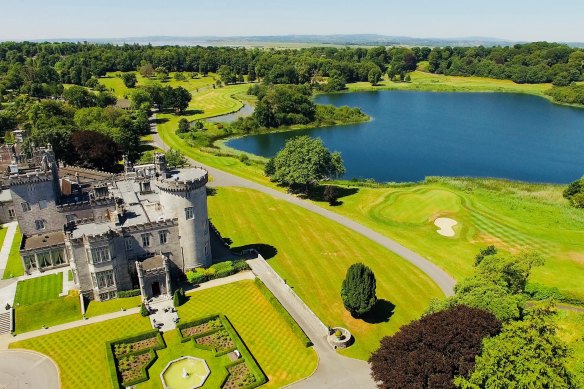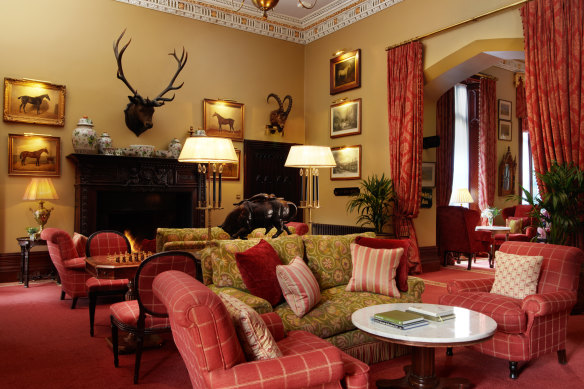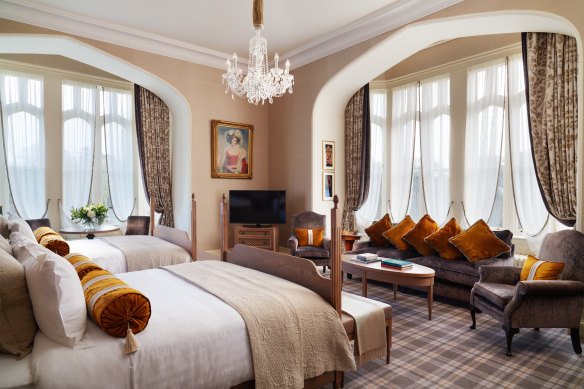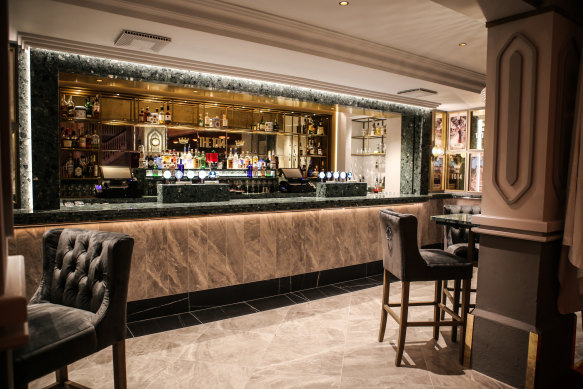This was published 2 years ago
This stunning castle is the birthplace of an unlikely Irish rebel
No trip to Ireland is complete without a visit to a castle. In a place with a troubled history, each Irish castle - and there are hundreds of them - has its own story to tell: stories of conflict, of resistance, or survival. At periods in Irish history, they were monuments to dispossession and invasion.
These days, Ireland’s castles are treasured landmarks of a history with which most Irish people are reconciled. They are monuments, as poet James Bird wrote, “of strength sublime”, giants “laughing at the threats of time”.

Ireland’s Dromoland Castle and its expansive grounds.Credit: Tourism Ireland
One such majestic castle, Dromoland - first constructed about 1500 - is also the starting point for a remarkable story which provides a unique historical connection between Ireland and Australia.
Located in Clare, a 15-minute drive from the county town of Ennis and an hour from the UNESCO World Heritage listed Cliffs Of Moher in Ireland’s south west, it’s now a stunning five-star hotel which has welcomed everyone from Nelson Mandela to The Beatles and Bill and Hillary Clinton into its lavish rooms.
It’s also the birthplace of an unlikely Irish rebel, who was transported to Tasmania in the mid-19th century.
Protestant aristocrat William Smith O’Brien (born 1803) did not fit the stereotype for a rebellious Irishman. Born into wealth and privilege, Smith O’Brien enjoyed a classical English education at Harrow and Trinity College Cambridge.
But according to local historian and distant relative Jane O’Brien, the young William became uneasy about the plight of the local people in County Clare.
“During his youth he had witnessed his mother’s philanthropic endeavours to improve the lives of the poor. She had established a needlework school to train girls from the local village,” O’Brien says.

Inside the so-called “Rebel’s Castle” which has an Australian link.
It was to become a preoccupation that would inspire a rebellion and ultimately helped to save Dromoland Castle itself from destruction.
Smith O’Brien became an MP in his mid-20s, sitting in the House Of Commons, and grew increasingly disillusioned about the lack of interest in Irish affairs among parliamentarians in Westminster.
He became a thorn in the side of the British government, obstructing parliamentary business with long speeches which highlighted the woes of ordinary Irish folk and was eventually imprisoned for contempt. Upon his release he was hailed a hero back in Ireland.
Meanwhile the potato famine, which began in earnest in 1845, fomented a burgeoning desire for rebellion. Smith O’Brien became increasingly militant.
He became leader of the rebel Young Ireland movement and helped plot a rebellion which took place in July 1848. The uprising was a failure – lasting just three days – but its ripples came to change Irish history. Smith O’Brien was arrested, charged and convicted for high treason. He was sentenced to death, but this was later commuted to deportation to Van Diemen’s Land after a public outcry in Ireland.
O’Brien and his principal lieutenants sailed in the Swift to Hobart Town, where they arrived on October 27, 1849.
Incarcerated initially at Maria Island he was eventually transferred to Port Arthur, where he was allowed to live in his own cottage. The building, which still bears his name, can be explored as part of a tour to Port Arthur.

A guest room at the castle.
Smith O’Brien was eventually pardoned and returned to Ireland. A statue of him stands on O’Connell Street in central Dublin. He died in 1864.
According to Jane O’Brien, his legacy helped to ensure that the place of his birth survived nationalist upheaval and the urge to destroy icons of Anglo privilege.
“[It] would have influenced the fortunes of Dromoland Castle when other great houses around Ireland were being burned during the revolutionary period of the 20th century,” she says.
As you enter the castle’s beautifully preserved stone and wood lobby today, a bronze plaque commemorates the building’s most celebrated inhabitant.
These days, the castle offers one of Ireland’s best heritage stays: think Downton Abbey with an Irish accent.
All the rooms have been refurbished with bespoke furniture and fittings which offer luxury and creature comforts. Accommodation ranges from the 30-square-metre Queen Anne entry-level rooms to the sumptuous Brian Boru suite, named after the once high king of Ireland from whom the O’Briens of Dromoland are descendants. We stay in the Inchiquin Stateroom, a stunning 46-square-metre space complete with its own intimate seating and dining area. Luxury fabrics and tasteful furnishings are matched by contemporary gadgets and breathtaking views over the lake and woodlands.
The castle hotel, easily accessible from Dublin (2.5 hours via the M7 and M18), sits on 182 hectares of manicured grounds which includes meandering woodland walks, a walled garden, tennis court, spa, pool and fitness centre. The 18-hole championship golf course (€70-€150 for 18 holes depending on the season) now hosts the annual Women’s Irish Open. To complete the Downton vibe, guests can sign up for a champagne picnic on the lake or an afternoon of clay pigeon shooting, archery or falconery.
Dining at Dromoland is carefully calibrated by long-time executive head chef David McCann to complement the period surroundings.
In the stunning Earl Of Thomond dining room, silver service is the order of the day. Under the gaze of extravagantly-framed portraits of O’Brien ancestors, you can feast on local fare like Clare Island organic salmon, monkfish and sea scallops.
Or choose dishes like pheasant, rabbit, wild duck and partridge, fauna which may well have come to grief from a hunter’s gun. Thus the menu warns: please note some game dishes may contain lead shot.

The bar at the luxury castle.Credit: Tourism Ireland
I choose the roast Black Angus fillet of beef with a Miso glazed short rib, aubergine, carrot and garlic confit followed by Bailey’s chocolate mousse for dessert. Delicious.
THE DETAILS
STAY
Dromoland Castle Hotel is accessible by road from Dublin Airport (2.5 hours via the M7 and M18), Shannon Airport (20 minutes via N17) or Cork Airport (two hours via N20). Accommodation ranges from the Queen Anne rooms (€495 - €700) to the Brian Boru suite (€2100 - €3250 a night). See dromoland.ie
EAT
The Gallery is perfect for a light lunch, afternoon tea or early evening casual bite. Try the Dromoland Castle Fish Pie with selected wild fish and shellfish, leeks, peas and buttered mash (€25) or the Wild Atlantic Sharing Plate with Sextons crab claws, Kelly oysters, Burren smoked salmon and mackerel, prawns, calamari and clams (€43). The Earl Of Thomond offers fine dining. Try the sustainable wild cod with chorizo remoulade , pink fir, shallot, kale and matlote sauce (€42) or the pot-roast guinea fowl, served with wild mushrooms, savoy cabbage, pearl onion, artichoke and truffle (€42).
MORE
Billy Cantwell stayed at Dromoland Castle as a guest of Tourism Ireland.
Sign up for the Traveller Deals newsletter
Get exclusive travel deals delivered straight to your inbox. Sign up now.